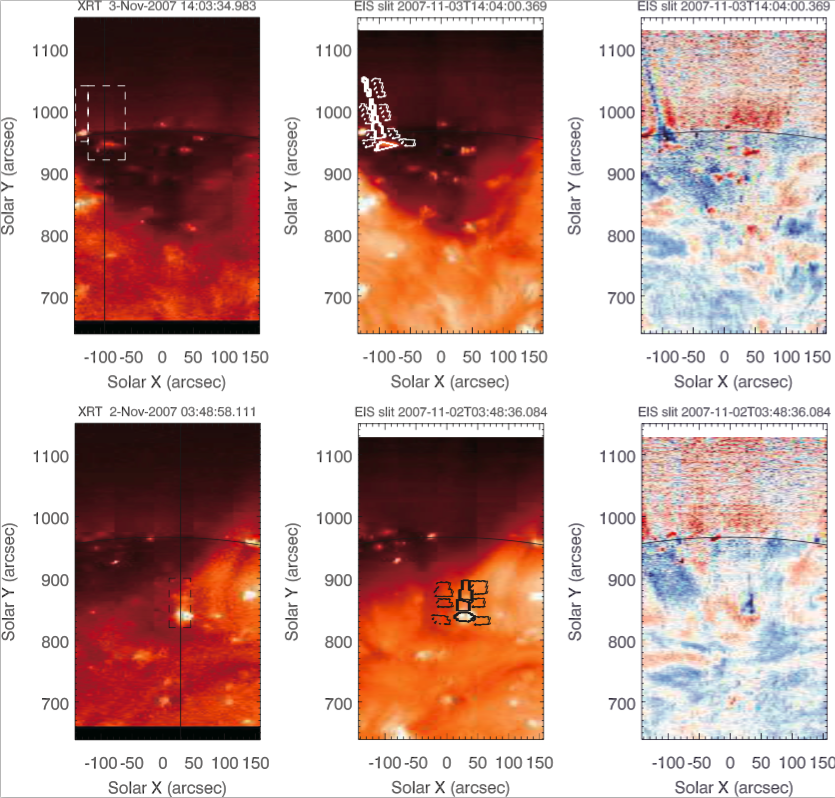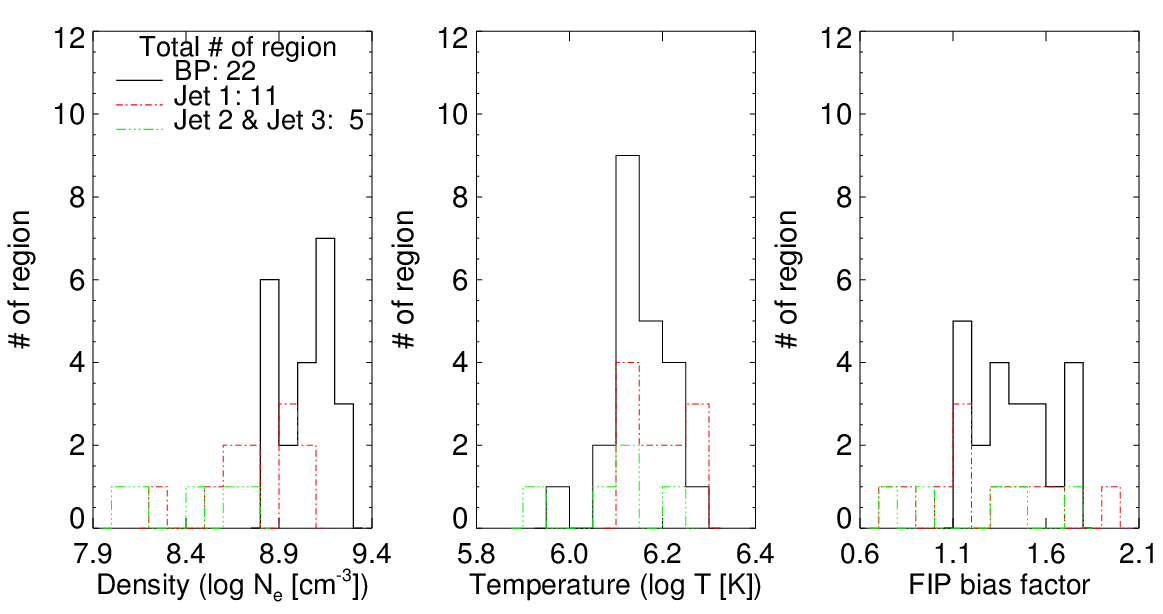Photospheric Abundances of Polar Jets on the Sun Observed by Hinode
Kyoung-Sun Lee, David H. Brooks, Shinsuke Imada

One of the most useful parameters for searching for fast and slow solar wind source regions is the difference in elemental composition. From in-situ measurements near Earth, it has been found that the composition of the fast solar wind is close to that of the solar photosphere while the composition of the slow solar wind is similar to the corona (Geiss et al. 1995; von Steiger et al. 2000). The differences between photospheric and coronal abundances can be related to the 'First Ionization Potential (FIP) effect.' Elements with a FIP below and above 10 eV are termed 'low FIP' and 'high FIP' elements, respectively. In coronal abundances, the low FIP elements are enhanced by factors of 3-4 relative to their photospheric abundances, while the high FIP elemental abundance doesn't change. Therefore, the FIP bias factor, which is the ratio of the elemental abundance in a specific region to the elemental abundance in the photosphere, indicates the relative abundances of the region we are interested in.
X-ray jets in the Sun's polar coronal holes have been suggested as one of the candidates to be a source of the fast solar wind along with coronal holes, plumes, and inter-plumes. It has been suggested that the jets are caused by magnetic reconnection, and Cirtain et al. (2007) observed a fast velocity component (approx 800 km/s) in X-ray jets. From their observed speeds and masses, they suggested that jets can contribute to the solar wind and that reconnection can accelerate the plasma into the solar wind.
Even though the abundances in the coronal holes, plumes, and inter-plumes were measured in previous studies (Feldman et al. 2005
; Guennou et al. 2015; Wilhelm & Bodmer 1998; Young et al. 1999), the abundances in polar jets have not been investigated yet. Therefore, we investigated the abundances in polar jets using the Hinode/EIS and tried to check the possibility that polar jets could be a source of the fast solar wind.
In Lee et al. (2015), we investigated 22 coronal jets seen in the north polar region of the Sun during 2007 November 1-3 by Hinode/XRT and EIS simultaneously. We obtained the intensities of the EIS spectral lines (Fe VIII - Fe XV, Si X, and S X) for the jets and nearby background regions by making masks for the bright point ('bp') at the base, and three parts of the jet regions which we label in Figure 1 as an example: 'jet 1' (middle), 'jet 2' (top), and 'jet 3' (end of the jet). We calculated the FIP bias factor from the ratio of the intensity between high (S) and low (Si, Fe) FIP elements using the EIS spectral line pair of Si X 258.37 and S X 264.23 Å together with DEM analysis, following the method developed by Brooks & Warren (2011).

Figure 1: Example of polar X-ray jets observed by XRT and EIS. Left column: intensity images in XRT Al poly filter. The dashed box and the vertical line indicate the location of the jet and EIS slit, respectively. Middle column: intensity images in EIS Fe XII 195.12 Å. The solid and dotted contours correspond to the regions of the jet and background regions nearby each part of the jets. Right column: Doppler velocity images in EIS Fe XII 195.12 Å.
Figure 2 shows the characteristics of the jets we analyzed. The black, green, and red lines in Figure 2 indicate the 'bp', 'jet 1', and 'jet 2 and jet 3' regions of the jets, respectively. The left and middle panels show the distributions of the density and temperature. The density and temperature values of the jets, which we measured in this analysis, are consistent with EIS measurements of polar jets reported in previous studies.

Figure 2: Histograms of the density (left), temperature (middle), and FIP bias factors (right) of the polar jets. Black, red, and green lines represent the regions of the polar jets; 'bp,' 'jet 1,' and 'jet 2 and jet 3,' respectively.
Our interesting new result is the measurement of the FIP bias factor. The right panel in Figure 2 shows the distribution of the FIP bias factor of the each region from the jets and BPs. The FIP bias factors are in the range 0.7-1.9, with an average value of about 1.2. Even though the range of the FIP bias factors is quite broad, most of the FIP bias factors (approx 75%) fall in the 0.7-1.5 range which is close to photospheric. The photospheric abundances of the polar jets and their BPs are consistent with the typical elemental composition of the fast solar wind reported from in situ measurements, suggesting that they could be a fast solar wind source.
Moreover, the photospheric abundances in the polar jets suggest that the whole process from emergence to reconnection of the jets occurs on a timescale shorter than is needed to change the abundances. The development timescales of the polar jets are mostly within several tens of minutes so that the abundances remain photospheric. Regarding the case of the higher values (1.6-1.9) of the FIP factors in our result, they correspond to several jets which occurred at the same BP which lasted for more than 3 hrs. The results may imply that the jet plasma is not normally confined long enough to change the abundances from photospheric to coronal, and is also new indirect evidence that the confinement time is critical for the process, as expected by e.g., Laming (2004).
References
Brooks, D. H., & Warren, H. P. 2011, ApJL, 727, L13
Cirtain, J. W., Golub, L., Lundquist, L., et al. 2007, Sci, 318, 1580
Feldman, U., Landi, E., & Schwadron, N. A. 2005, JGR, 110, 10918
Geiss, J., Gloeckler, G., & von Steiger, R. 1995, SSRv, 72, 49
Guennou, C., Hahn, M., & Savin, D. W. 2015, ApJ, 807,145
Laming, J. M. 2004, ApJ, 614, 1063
Lee, K.-S., Brooks, D. H., & Imada, S. 2015, ApJ, 809, 114
(See: http://iopscience.iop.org/article/10.1088/0004-637X/809/2/114 )
von Steiger, R., Schwadron, N. A., Fisk, L. A., et al. 2000, JGR, 105, 27217
Wilhelm, K., & Bodmer, R. 1998, SSRv, 85, 371
Young, P. R., Klimchuk, J. A., & Mason, H. E. 1999, A&A, 350, 286
Next EIS Nugget »» coming later...
TBC
Last Revised: 16-Dec-2015
Feedback and comments: webmaster
|


